


BATS
Introduction
Conservation and Public Education
Despite their ecological value, bats are relentlessly and unjustifiably
persecuted. Bats are often killed because they live near people who needlessly
fear them. These actions emphasize the need to educate the public on
the reasons for bat conservation and why it is important to use safe,
nondestructive methods to alleviate conflicts between people and bats.
General sources of information on bats include states’ Cooperative Extension
Services, universities, government environmental conservation and health
departments, and Bat Conservation International (Austin, Texas). Except
where control is necessary, bats should be appreciated from a distance
— and not disturbed.
Identification and Range
Bats, the only mammals that truly fly, belong to the order Chiroptera.
Their ability to fly, their secretiveness, and their nocturnal habits
have contributed to bat folklore, superstition, and fear. They are worldwide
in distribution and include about 900 species, second in number only
to Rodentia (the rodents) among the mammals.
Among the 40 species of bats found north of Mexico, only a few cause problems for humans (note that vampire bats are not found in the United States and Canada). Bats congregating in groups are called colonial bats; those that live a lone existence are known as solitary bats.
The colonial species most often encountered in and around human buildings in the United States are the little brown bat, (Myotis lucifugus), the big brown bat (Eptesicus fuscus), the Mexican free-tailed bat (Tadarida brasiliensis,), the pallid bat (Antrozous pallidus), the Yuma myotis (Myotis yumanensis), and the evening bat (Nycticeius humeralis).
Solitary bats typically roost in tree foliage or under bark, but occasionally are found associated with buildings, some only as transients during migration. These include Keen’s bat (Myotis keenii), the red bat (Lasiurus borealis), the silver-haired bat (Lasionycteris noctivagans), and the hoary bat (Lasiurus cinereus). Excellent illustrations of all bats discussed herein can be found in Barbour and Davis (1979), Tuttle (1988), Geluso et al. (1987), and Harvey (1986).
Several species of bats have been included here, with significant interspecific differences that need to be clarified if well-planned, comprehensive management strategies are to be developed. Any problems caused by bats are limited to species distribution; thus animal damage control personnel need not be concerned with every species.
Colonial and solitary bats have obvious differences that serve to separate the species into groups. Much of the descriptive material that follows is adapted from Barbour and Davis (1979).
Colonial Bats
Little brown bat (Myotis lucifugus)
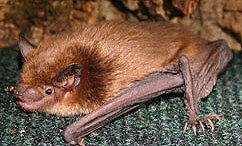
Recognition
forearm — 1.34 to 1.61 inches (3.4 to 4.1 cm)
wingspan — 9.02 to 10.59
inches (22.9 to 26.9 cm)
ears — 0.55 to 0.63 inches (1.4 to 1.6 cm)
foot — approximately 0.39 inches
(1.0 cm); long hairs on toes extend beyond claws.
Color
Pale tan through reddish brown to dark brown, depending on geographic
location. The species is a rich dark brown in the eastern United States
and most of the west coast. Fur is glossy and sleek.
Confusion may occur with a few other “house” bat species. In the East, it may be confused with Keen’s bat (M. keenii), which has longer ears [0.69 to 0.75 inches (1.7 to 1.9 cm)] and a longer, more pointed tragus (the appendage at the base of the ear). In the West, it resembles the Yuma myotis (M. yumanensis), which has dull fur and is usually smaller. However, the Yuma myotis and little brown may be indistinguishable in some parts of the northwestern United States where they may hybridize.
Habits
This is one of the most common bats found in and near buildings, often
located near a body of water where they forage for insect prey. Summer
colonies are very gregarious, commonly roosting in dark, hot attics and
associated roof spaces where maternity colonies may include hundreds
to a few thousand individuals. Colonies may also form beneath shingles
and siding, in tree hollows, beneath bridges, and in caves. Litter size
is 1 in the Northeast; twins occasionally occur in some other areas.
The roost is often shared with the big brown bat (E. fuscus) though the
latter is less tolerant of high temperatures; M. keenii may also share
the same site. Separate groups of males tend to be smaller and choose
cooler roosts within attics, behind shutters, under tree bark, in rock
crevices, and within caves.
In the winter, little brown bats in the eastern part of their range abandon buildings to hibernate in caves and mines. Such hibernacula may be near summer roosts or up to a few hundred miles (km) away. Little is known of the winter habits of M. lucifugus in the western United States.
The life span of little brown bats has been established to be as great
as 31 years. The average life expectancy, however, is probably limited
to only a few years.
Big brown bat (Eptesicus fuscus)

Recognition
forearm — 1.65 to 2.01 inches (4.2 to 5.1 cm)
wingspan
— 12.80 to 13.78 inches (32.5 to 35.0 cm)
ears — with rounded tragus
Color
From reddish brown, copper colored, to a dark brown depending on geographic
location. This is a large bat without distinctive markings.
Confusion may occur with the evening bat (Nycticeius humeralis) though the latter is much smaller.
Habits
This hardy, rather sedentary species appears to favor buildings for
roosting. Summer maternity colonies may include a dozen or so and up
to a few hundred individuals, roosting behind chimneys, in enclosed eaves,
in hollow walls, attics, barns, and behind shutters and unused sliding
doors. They also form colonies in rock crevices, beneath bridges, in
hollow trees, and under loose bark. Litter size is 2 in the East to the
Great Plains; from the Rockies westward 1 young is born.
E. fuscus frequently shares roosts with M. lucifugus in the East, and with M. yumanensis, Taderida, and Antrozous in the West. Males typically roost in smaller groups or alone during the summer.
The big brown bat is one of the most widely distributed of bats in the United States and is probably familiar to more people than any other species. This is partially due to its large, easy-to-observe size, but also to its ability to overwinter in buildings (attics, wall spaces, and basements). Its close proximity to humans, coupled with its tendency to move about when temperature shifts occur, often brings this bat into human living quarters and basements in summer and winter. Big browns also hibernate in caves, mines, storm sewers, burial vaults, and other underground harborage. While E. fuscus will apparently travel as far as 150 miles (241 km) to hibernacula, the winter quarters of the bulk of this species are largely unknown.
Big brown bats may live as long as 18 years.
Mexican free-tailed bat (Tadarida
brasiliensis)

Recognition
forearm — 1.42 to 1.81 inches (3.6 to 4.6 cm)
wingspan — 11.42 to 12.80
inches (29.0 to 32.5 cm); long narrow wings
tail (interfemoral) membrane
— does not enclose the lower one-third to one-half of the tail, hence
the name free-tailed
foot — long, stiff hairs as long as the foot protrude
from the toes.
Color
Dark brown or dark gray. Fur of some individuals may have been bleached
to a pale brown due to ammonia fumes from urine and decomposing guano.
Confusion is not likely to occur with other species that commonly inhabit human buildings.
Habits
T. brasiliensis forms the largest colonies of any warm-blooded animal,
establishing sizable colonies in buildings, particularly on the West
Coast and in the Gulf states from Texas east. Hundreds to thousands may
be found in buildings or under bridges. It is primarily a cave bat in
Arizona, New Mexico, Oklahoma, and Texas; buildings are used as temporary
roosts during migrations. Litter size is 1.
Taderida often share roosts with other species. In the West, for example, they may be found in buildings with A. pallidus, M. yumanensis, and E. fuscus. Some males are always present in the large maternity colonies, but they tend to segregate in separate caves.
A few Taderida may overwinter in buildings as far north as South Carolina
in the East and Oregon in the West. Most of this species migrate hundreds
of miles to warmer climes (largely to Mexico) for the winter.
Pallid bat (Antrozous pallidus)
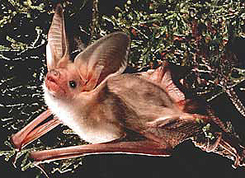
Recognition
forearm — 1.89 to 2.36 inches (4.8 to 6.0 cm)
wingspan — 14.17 to 15.35
inches (36.0 to 39.0 cm)
ears — large; widely separated and more than
half as broad as long. The ears are nearly half as long as the combined
length of the bat’s head and body.
eyes — large
Color
pale, upper parts are light yellow, the hairs tipped with brown or
gray. Underparts are pale creamy, almost white. This large, light-colored
bat is relatively easy to recognize.
Confusion with other species that commonly inhabit human buildings is not likely to occur.
Habits
Maternity colony size ranges from about 12 to 100 individuals. Roost
sites include buildings, bridges, and rock crevices; less frequently,
tree cavities, caves, and mines. Litter size is most commonly 2. The
roost is frequently shared with T. brasiliensis and E. fuscus in the
West. While groups of males tend to segregate during the nursery period
(sometimes in the same building), other males are found within the maternity
colony.
An interesting feature of pallid bats is that they fly close to the ground, may hover, and take most prey on the ground, not in flight. Prey includes crickets, grasshoppers, beetles, and scorpions. They will also forage among tree foliage.
Pallid bats are not known to make long migrations, though little is
known of their winter habits.
Yuma myotis (Myotis yumanensis)
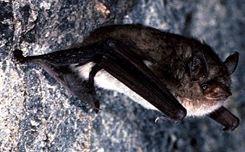
Recognition
forearm — 1.26 to 1.50 inches (3.2 to 3.8 cm)
wingspan — about 9.25
inches (23.5 cm)
ears — 0.55 to 0.59 inches (1.4 to 1.5 cm)
foot — 0.39 inches (1.0 cm)
Color
Light tan to dark brown; underside is whitish to buffy.
Confusion may occur in the West with M. lucifugus, though the latter tends to have longer, glossier fur, and is larger. In the Northwest, hybridization occurs with M. lucifugus, making the species indistinguishable.
Habits
Maternity colonies, up to several thousand individuals, form in the
summer in attics, belfries, under bridges, and in caves and mines. Litter
size is 1. Males typically segregate during the nursery period and roost
as solitary individuals in buildings and other suitable harborage.
M. yumanensis is more closely associated with water than is any other North American bat species. Nearly all roosts have open water nearby. This species is not as tolerant as M. lucifugus of high roost temperatures and will move to cooler niches within a building when temperatures rise much above 100°F (37.8°C).
M. yumanensis abandons maternity colonies in the fall, but its winter habitat is not known.
Evening bat (Nycticeius
humeralis)

Recognition
forearm — 1.30 to 1.54 inches (3.3 to 3.9 cm)
wingspan — 10.24 to 11.02
inches (26.0 to 28.0 cm)
ears — with short, curved, and rounded tragus
Confusion may occur with the big brown bat (E. fuscus), which can be readily distinguished by its larger size. It bears some resemblance to the somewhat smaller little brown bat (M. lucifugus) but can be identified by its characteristic blunt tragus.
Color
Medium brown with some variation to yellow-brown in subtropical Florida.
No distinctive markings.
Habits
Summer maternity colonies in buildings may consist of hundreds of individuals.
Litter size is usually 2. Colonies also form in tree cavities and under
loose tree bark. In the Southeast, T. brasiliensis commonly inhabits
the same building with N. humeralis. This is one of the most common bats
in towns throughout the southern coastal states. Very little is known
about this species, and virtually nothing is known of its winter habitat
except that it almost never enters caves.
Solitary Bats
Keen’s bat (Myotis keenii)
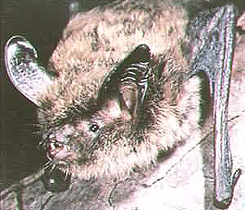
Recognition
forearm — 1.26 to 1.54 inches (3.2 to 3.9 cm)
wingspan — 8.98 to 10.16
inches (22.8 to 25.8 cm)
ears — 0.67 to 0.75 inches (1.7 to 1.9 cm); with
a long, narrow, pointed tragus
Color
Brown, but not glossy; somewhat paler in the East.
Confusion may occur with M. lucifugus, which has glossy fur, shorter ears, and does not have the long, pointed tragus.
Habits
Excluding small maternity colonies (up to 30 individuals are on record),
M. keenii are generally found singly in the East. Roosting sites include:
behind shutters, under wooden shingles, sheltered entryways of buildings,
in roof spaces, in barns, and beneath tree bark. In the West, this bat
is known as a solitary species, roosting in tree cavities and cliff crevices.
Litter size is probably 1. The roost is sometimes shared with M. lucifugus.
The sexes probably segregate during the nursery period. In winter, these
bats hibernate in caves and mines.
Red Bat (Lasiurus borealis)

Recognition
forearm — 1.38 to 1.77 inches (3.5 to 4.5 cm)
wingspan — 11.42 to 13.07
inches (29.0 to 33.2 cm); long, pointed wings
ears — short rounded
tail membrane — heavily furred on upper surface,
with a distinctive long tail.
Color
Bright orange to yellow-brown; usually with a distinctive white mark
on the shoulders.
Confusion may occur with the hoary bat (L. cinereus), which is frosted-gray in appearance and larger.
Habits
Red bats live solitary lives, coming together only to mate and migrate.
Few people are familiar with this species. They typically spend summer
days hidden in the foliage of deciduous trees. The number ofyoung ranges
from 1 to 4, averaging 2.3.
These bats often chase insects that are attracted to lights, such as street lamps. It is this behavior that most likely brings them in close proximity to people.
L. borealis is well-adapted for surviving drastic temperature fluctuations; it does not hibernate in caves, but apparently in trees. Some migrate long distances. During migration, red bats have been known to land on high-rise buildings and on ships at sea.
Silver-haired bat (Lasionycteris noctivagans)
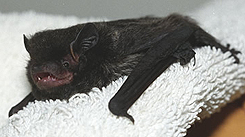
Recognition
forearm — 1.46 to 1.73 inches (3.7 to 4.4 cm)
wingspan — 10.63 to 12.20
inches (27.0 to 31.0 cm)
ears — short, rounded, hairless
tail membrane — upper surface is sparsely
furred on the anterior one-half.
Color
Usually black with silver-tipped fur; some individuals with dark
brown, yellowish-tipped fur.
Confusion sometimes occurs with the larger hoary bat (Lasiurus cinereus), which has patches of hair on the ears and wings, heavy fur on the entire upper surface of the tail membrane, and has a distinctive throat “collar.”
Habits
The silver-haired bat roosts in a wide variety of harborages. A typical
roost might be behind loose tree bark; other sites include tree hollows
and bird nests. This species is solitary except when with young. Additionally,
there are unconfirmed reports that it is sometimes colonial (Dalquest
and Walton 1970) and may roost in and on buildings. The litter size is
2. The sexes segregate through much of the summer range.
L. noctivagans hibernates in tree crevices, under loose bark, in buildings
(including churches, sky scrapers, and wharf houses), hulls of ships,
rock crevices, silica mines, and non-limestone caves. It also may migrate,
during which time it is encountered in buildings (they favor open sheds,
garages, and outbuildings rather than enclosed attics), in lumber piles,
and on ships at sea.
Hoary bat (Lasiurus cinereus)
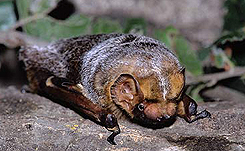
Recognition
forearm — 1.81 to 2.28 inches (4.6 to 5.8 cm)
wingspan — 14.96 to 16.14
inches (38.0 to 41.0 cm)
ears — relatively short, rounded, edged with
black, and with fur
tail membrane — completely furred on upper surface
Color
Dark, but many hairs are tipped in white, giving it a frosted
appearance. This bat also has a yellowish or orangish throat “collar.”
Confusion may sometimes occur with the much smaller silver-haired bat (Lasionycteris noctivagans), which lacks the fur patches and markings on the ears, markings on the throat, and has a tail membrane that is only lightly furred on the upper surface.
Habits
Hoary bats generally spend summer days concealed in tree foliage (often
in evergreens), rarely enter houses, and are not commonly encountered
by people. L. cinereus at their day roosts are usually solitary except
when with young. The litter size is 2. The sexes segregate through most
of the summer range.
This is one of the largest bats in North America, a powerful flier, and an accomplished migrant. Records indicate that some L. cinereus may hibernate in northern parts of their range.
General Biology, Reproduction, and Behavior
Most North American bats emit high frequency sounds (ultrasound) inaudible to humans and similar to sonar, in order to avoid obstacles, locate and capture insect prey, and to communicate. Bats also emit audible sounds that may be used for communication between them.
Bats generally mate in the fall and winter, but the female retains the sperm in the uterus until spring, when ovulation and fertilization take place. Pregnant females may congregate in maternity colonies in buildings, behind chimneys, beneath bridges, in tree hollows, caves, mines, or other dark retreats. No nests are built. Births typically occur from May through July. Young bats grow rapidly and are able to fly within 3 weeks. Weaning occurs in July and August, after which the nursery colonies disperse.
Bats prepare for winter around the time of the first frost. Some species migrate relatively short distances, whereas certain populations of the Mexican free-tailed bat may migrate up to 1,000 miles (1,600 km). Bats in the northern United States and Canada may hibernate from September through May. Hibernation for the same species in the southern part of their range may be shorter or even sporadic. Some may fly during warm winter spells (as big brown bats may in the northeastern part of the United States). Bats often live more than 10 years.
In response to a variety of human activities, direct and indirect, several bat species in the United States have declined in number during the past few decades. Chemical pesticides (particularly the use of persistent and bioaccumulating organic pesticides) have decreased the insect supply, and contaminated insects ingested by bats have reduced bat populations. Many bats die when people disturb summer maternity roosts and winter hibernacula. Vandals and other irresponsible individuals may deliberately kill bats in caves and other roosts. Even the activities of speleologists or biologists may unintentionally disturb hibernating bats, which depletes fat reserves needed for hibernation.
Modification and destruction of roost sites has also decreased bat numbers.
Sealing and flooding of mineshafts and caves and general quarrying operations
may inadvertently ruin bat harborages. Forestry practices have reduced
the number of hollow trees available. Some of the elimination of natural
bat habitat may contribute to bats roosting in buildings.
Bat Presence
Bats often fly about swimming pools, from which they drink or catch
insects. White light (with an ultraviolet component), commonly used for
porch lights, building illumination, street and parking-lot lights, may
attract flying insects, which in turn attract bats. Unfortunately, the
mere presence of a bat outdoors is sometimes beyond the tolerance of
some uninformed people. Information is a good remedy for such situations.
Bats commonly enter buildings through openings associated with the roof edge and valleys, eaves, apex of the gable, chimney, attic or roof vent, dormers, and siding.
Other openings may be found under loose-fitting doors, around windows, gaps around various conduits (wiring, plumbing, air conditioning) that pass through walls, and through utility vents.
Bats are able to squeeze through narrow slits and cracks. For purposes of bat management, one should pay attention to any gap of approximately 1/4 x 1 1/2 inches (0.6 x 3.8 cm) or a hole 5/8 x 7/8 inch (1.6 x 2.2 cm). Such openings must be considered potential entries for at least the smaller species, such as the little brown bat. The smaller species require an opening no wider than 3/8 inch (0.95 cm), that is, a hole the diameter of a US 10-cent coin (Greenhall 1982). Openings of these dimensions are not uncommon in older wood frame structures where boards have shrunk, warped, or otherwise become loosened.
The discovery of one or two bats in a house is a frequent problem. In
the Northeast, big brown bats probably account for most sudden appearances.
Common in urban areas, they often enter homes through open windows or
unscreened fireplaces. If unused chimneys are selected for summer roosts,
bats may fall or crawl through the open damper into the house. Sometimes
bats may appear in a room, then disappear by crawling under a door to
another room, hallway, or closet. They may also disappear behind curtains,
wall hangings, bookcases, under beds, into waste baskets, and so forth.
Locating and removing individual bats from living quarters can be laborious
but is important. If all else fails, wait until dusk when the bat may
appear once again as it attempts to find an exit. Since big brown bats
may hibernate in the cooler recesses of heated buildings, they may suddenly
appear (flying indoors or outdoors) in midwinter during a warm spell
or a cold snap as they move about to adjust to the temperature shift.
Food Habits
Bats in North America are virtually all insectivorous, feeding on
a variety of flying insects (exceptions among house bats were noted previously).
Many of the insects are harmful to humans. While there must be some limitations
based on such factors as bats’ body size, flight capabilities, and jaw
opening, insectivorous bats apparently consume a wide range of prey (Barbour
and Davis 1979). The little brown bat’s diet includes mayflies, midges,
mosquitoes, caddis flies, moths, and beetles. It can consume insects
equal to one-third of its body weight in 1/2 hour of foraging. The big
brown bat may fill its stomach in about 1 hour (roughly 0.1 ounce per
hour [2.7 g/hr]) with prey including beetles, moths, flying ants, true
bugs, mayflies, caddis flies, and other insects. The nightly consumption
of insects by a colony of bats can be extremely large.
Damage and Damage Identification
Roosting Sites
Bats use roosting niches that are indoors (human dwellings, outbuildings,
livestock quarters, warehouses), semi-enclosed (loading docks, entrance
foyers), partially sheltered (porches, carports, pavilions, highway underpasses,
bridges), and open structural areas (window shutters, signs). Once there,
active bats in and on buildings can have several economic and aesthetic
effects, often intertwined with public health issues (Frantz, 1988).
Unusual roosting areas include wells, sewers, and graveyard crypts. Before
considering control measures, verify that bats are actually the cause
of the problem.
Rub Marks
Surface areas on walls, under loose woodwork, between bricks
and around other bat entryways often have a smooth, polished appearance.
The stained area is slightly sticky, may contain a few bat hairs, and
is yellow-brown to blackish brown in color. The smooth gloss of these
rub marks is due to oils from fur and other bodily secretions mixed with
dust, deposited there as many animals pass repeatedly for a long period
over the same surface. Openings marked in this way have been used heavily
by bats.
Noise
Disturbing sounds may be heard from vocalizations and grooming, scratching,
crawling, or climbing in attics, under eaves, behind walls, and between
floors. Bats become particularly noisy on hot days in attics, before
leaving the roost at dusk, and upon returning at dawn. Note that rustling
sounds in chimneys may be caused by birds or raccoons and scratching
and thumping sounds in attics and behind walls may indicate rats, mice,
or squirrels.
Guano and Urine
Fecal pellets indicate the presence of animals and are found on attic
floors, in wall recesses, and outside the house at its base. Fecal pellets
along and inside walls may indicate the presence of mice, rats, or even
roaches. Since most house bats north of Mexico are insectivorous, their
droppings are easily distinguished from those of small rodents. Bat droppings
tend to be segmented, elongated, and friable. When crushed, they become
powdery and reveal shiny bits of undigested insect remains. In contrast,
mice and rat droppings tend to taper, are unsegmented, are harder and
more fibrous, and do not become powdery when crushed (unless extremely
aged).
The droppings of some birds and lizards may occasionally be found along with those of bats. However, bat droppings never contain the white chalky material characteristic of the feces of these other animals.
Bat excrement produces an unpleasant odor as it decomposes in attics, wall spaces, and other voids. The pungent, musty, acrid odor can often be detected from outside a building containing a large or long-term colony. Similar odor problems occur when animals die in inaccessible locations. The odor also attracts arthropods which may later invade other areas of a building.
Bat guano may provide a growth medium for microorganisms, some of which are pathogenic (histoplasmosis, for example) to humans. Guano accumulations may fill spaces between walls, floors, and ceilings. It may create a safety hazard on floors, steps, and ladders, and may even collapse ceilings. Accumulations also result in the staining of ceilings, soffits, and siding, producing unsightly and unsanitary conditions.
Bats also urinate and defecate in flight, causing multiple spotting and staining on sides of buildings, windows, patio furniture, automobiles, and other objects at and near entry/exit holes or beneath roosts. Bat excrement may also contaminate stored food, commercial products, and work surfaces.
Bat urine readily crystallizes at room temperature. In warm conditions under roofs exposed to sun and on chimney walls, the urine evaporates so quickly that it crystallizes in great accumulations. Boards and beams saturated with urine acquire a whitish powderlike coating. With large numbers of bats, thick and hard stalactites and stalagmites of crystallized bat urine are occasionally formed.
Although the fresh urine of a single bat is relatively odorless, that of any moderate-sized colony is obvious, and the odor increases during damp weather. Over a long period of time urine may cause mild wood deterioration (Frantz and Trimarchi 1984). As the urine saturates the surfaces of dry wood beams and crystallizes, the wood fibers expand and separate. These fibers then are torn loose by the bats crawling over such surfaces, resulting in wood fibers being mixed with guano accumulations underneath.
The close proximity of bat roosts to human living quarters can result in excreta, animal dander, fragments of arthropods, and various microorganisms entering air ducts as well as falling onto the unfortunate residents below. Such contaminants can result in airborne particles of public health significance (Frantz 1988).
Ectoparasites and other Arthropods
Several arthropods (fungivores, detritivores,
predators, and bat ectoparasites) are often associated with colonies
of bats in buildings. Their diversity depends on the number of bats,
age and quantity of excreta deposits, and season.Arthropods such as dermestid
beetles (Attagenus megatoma) contribute to the decomposition of guano
and insect remnants, but may also become a pest of stored goods and/or
a nuisance within the living quarters. Cockroaches (for example, Blatta
orientalis) attracted to guano may invade other parts of a building.
Bat bugs (Cimex spp.) are sometimes found crawling on the surface of
beams or around holes leading to secluded recesses used by bats. Bat
ectoparasites (ticks, mites, fleas, and bugs) rarely attack humans or
pets and quickly die in the absence of bats. Ectoparasites may become
a nuisance, however, following exclusion of large numbers of bats from
a well-established roost site. Area fumigation with a total release pyrethrum
based aerosol may be an appropriate solution for arthropod knockdown
within an enclosed space, but only after bats have departed. For long-term
arthropod control, lightly dust appropriate surfaces (affected attic
beams, soffits) with boric acid powder or diatomaceous earth; carefully
read all product labels before using any pesticide. Note that neither
rabies nor Lyme disease is transmitted by any arthropods associated with
bats.
Public Health Issues
Rabies
General Epidemiology Bats are distinct
from most vertebrate pests that inhabit human dwellings because of the
potential for transmitting rabies — a viral infection of mammals that
is usually transmitted via the bite of an infected animal. Rabies does
not respond to antibiotic therapy and is nearly always fatal once symptoms
occur. However, because of the long incubation period (from 2 weeks to
many months), prompt vaccination following exposure can prevent the disease
in humans. Dogs, cats, and livestock also can be protected by periodic
vaccinations. Bats are not asymptomatic carriers of rabies. After an
incubation period of 2 weeks to 6 months, they become ill with the disease
for as long as 10 days. During this latter period, a rabid bat’s behavior
is generally not normal—it may be found active during the daytime or
on the ground incapable of flying. Most human exposures are the result
of accidental or careless handling of grounded bats. Even less frequently,
bats in this stage of illness may be involved in unprovoked attacks on
people or pets (Brass, pers. commun.; Trimarchi et al. 1979). It is during
this stage that the rabid bat is capable of transmitting the disease
by biting another mammal. As the disease progresses the bat becomes increasingly
paralyzed and dies as a result of the infection. The virus in the carcass
is reported to remain infectious until decomposition is well advanced.
Significance
Rabies
is the most important public health hazard associated with bats. Infection
with rabies has been confirmed in all 40 North American species of bats
that have been adequately sampled in all of the contiguous United States
and in most provinces of Canada. Figure 8 shows the frequency of bat
species submitted for rabies testing in New York State over the last
12 years. While not a nationwide measure of human encounters with bats,
Figure 8 illustrates that bat species are not encountered equally. Note
that bats submitted for testing are often ill and/or easily captured.
The numbers and species encountered will vary with the region of the
country; data are generally available from local and state health authorities.
Random sampling of bats (healthy and ill) indicates an overall infection rate of less than 1%. Finding a rabid bat in a colony does not imply that the remaining animals are rabid. In fact, the probability of immediately finding more than one additional infected bat in that colony is small.
Bats rank third (behind raccoons and skunks) in incidence of wildlife rabies in the United States (Krebs et al. 1992). In the last 20 years, however, there have been more human rabies cases of bat origin in the United States than of any other wildlife group. Furthermore, the disease in bats is more widely distributed (in all 48 contiguous states in 1989) than in any other species. In Canada, bats also rank third (behind foxes and skunks) in the incidence of wildlife rabies. Therefore, every bat bite or contact must be considered a potential exposure to rabies. While aerosol transmission of the rabies virus from bats in caves to humans and some other mammals has been reported, this is not a likely route of infection for humans entering bat roosts in buildings in temperate North America. Note that vampire bats are not a threat north of Mexico.
Histoplasmosis—General Epidemiology
Histoplasmosis is a very common
lung disease of worldwide distribution caused by a microscopic fungus,
Histoplasma capsulatum. Histoplasma exists in nature as a saprophytic
mold that grows in soil with high nitrogen content, generally associated
with the guano and debris of birds (particularly starlings, Sturnus vulgaris,
and chickens) and bats. Wind is probably the main agent of dispersal,
but the fungus can survive and be transmitted from one site to another
in the intestinal contents of bats, and also in the dermal appendages
of both bats and birds. The disease can be acquired by the casual inhalation
of windblown spores, but infections are more likely to result from visits
to point sources of growth of the fungus. Relative to bats, such sources
include bat roosts in caves, barns, attics, and belfries, and soil enriched
with bat guano.
Numerous wild and domestic animals are susceptible to histoplasmosis, but bats (and perhaps the armadillo) are the only important animal vectors. Unlike bats, birds do not appear to become infected with the fungus. Both the presence of guano and particular environmental conditions are necessary for H. capsulatum to proliferate. In avian habitats, the organism apparently grows best where the guano is in large deposits, rotting and mixed with soil rather than in nests or in fresh deposits. Specific requirements regarding bats have not been described, though bat roosts with long-term infestation are often mentioned in the literature.
While histoplasmosis in the United States is particularly endemic to the Ohio-Mississippi Valley region (which is also an area with the greatest starling concentration) and areas along the Appalachian Mountains, it is also found in the lake and river valleys of other states. Outside areas with “appropriate” environmental conditions, there also occur scattered foci with high infection rates usually associated with caves inhabited by bats or birds.
Significance
When soil or guano containing H. capsulatum is physically
disturbed, the spores become airborne. Persons at particular risk of
histoplasmosis of bat origin include spelunkers, bat biologists, pest
control technicians, people who clean out or work in areas where bats
have habitually roosted, and people in contact with guano-enriched soil
— such as around the foundation of a building where guano has sifted
down through the walls.
Infection occurs upon inhalation of spores and can result in a variety of clinical manifestations; severity partially depends on the quantity of spores inhaled. The infection may remain localized in the lungs where it may resolve uneventfully; this is the case for about 95% of the 500,000 infections occurring annually in the United States. Such infections are identified only by the presence of a positive histoplasmin skin test and/or calcified lesions on routine radiographs. Other individuals may have chronic or progressive lung disease requiring treatment. Less severe forms of these infections may be accompanied by fever, cough, and generalized symptoms similar to a prolonged influenza. Resolution of the disease confers a degree of immunity to reinfection. In addition, resolution confers varying degrees of hypersensitivity to H. capsulatum; as a consequence, massive reinfection in highly sensitized lungs may result in a fatal acute allergic reaction.
In a small percentage of chronic histoplasmosis cases, the fungus disseminates to involve multiple organ systems and may be fatal. This form is usually seen in young children (1 year or older) and in immunocompromised adults. In recent years, systemic infections have been increasing in frequency globally as an opportunistic infection of AIDS patients.
Legal Status
The lethal control of bats, even when there is a proven potential danger to humans, often is subjected to careful scrutiny and interagency coordination. A survey of federal legislative actions, court decisions, and agency interpretations concerning bats can be found in Bat Management in the United States (Lera and Fortune 1979).
Some states have laws that specifically mention bats, either providing
or denying protection. Others have legislation that applies to bats only
by interpretation, since bats may be considered nongame wildlife or indigenous
state mammals. Some bats have protection as either federal or state-listed
endangered species, but the same state may not protect other species
of bats. Enforcement and public education must accompany legislation
to accomplish the intended goal of protecting the public and saving endangered
bats. Familiarity with the appropriate federal and state laws should
precede any nuisance management activities.
Bats Birds Chipmunks Feral Cats Mice Opossums Raccoons Skunks Snakes Squirrels Woodchucks

